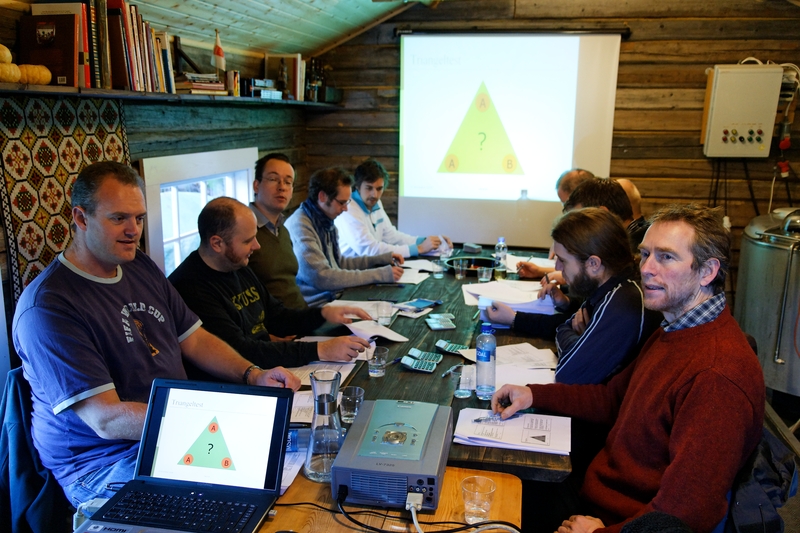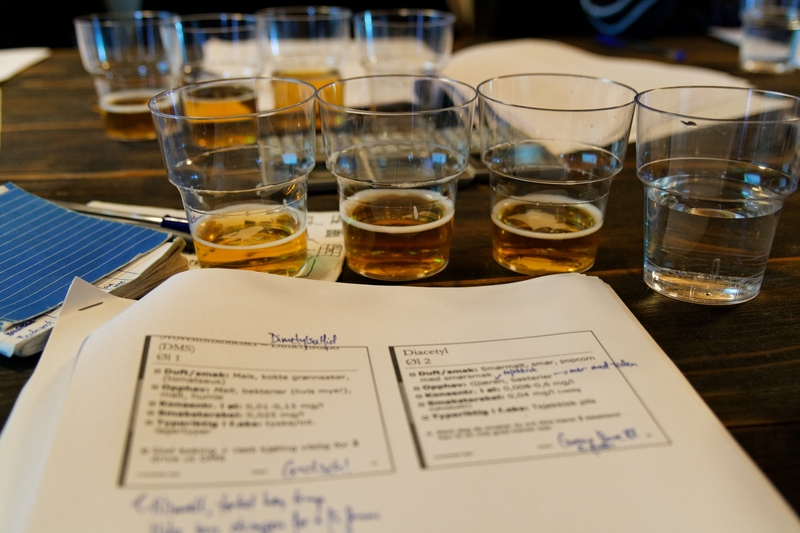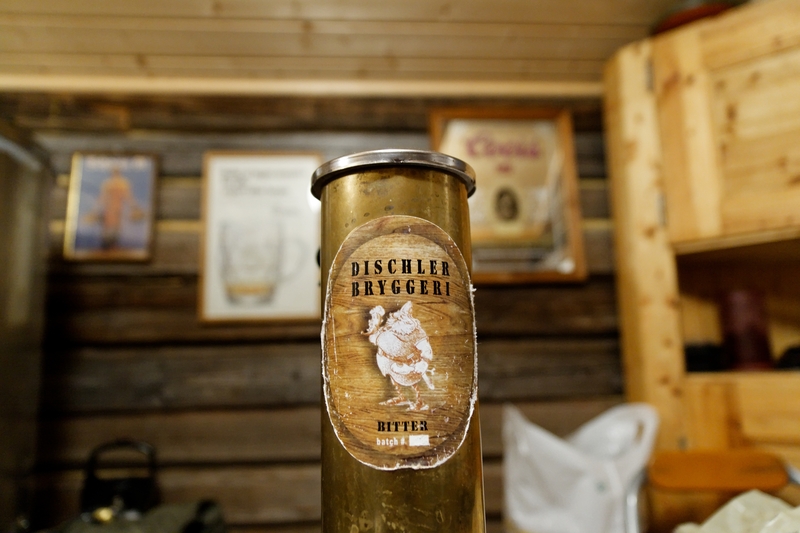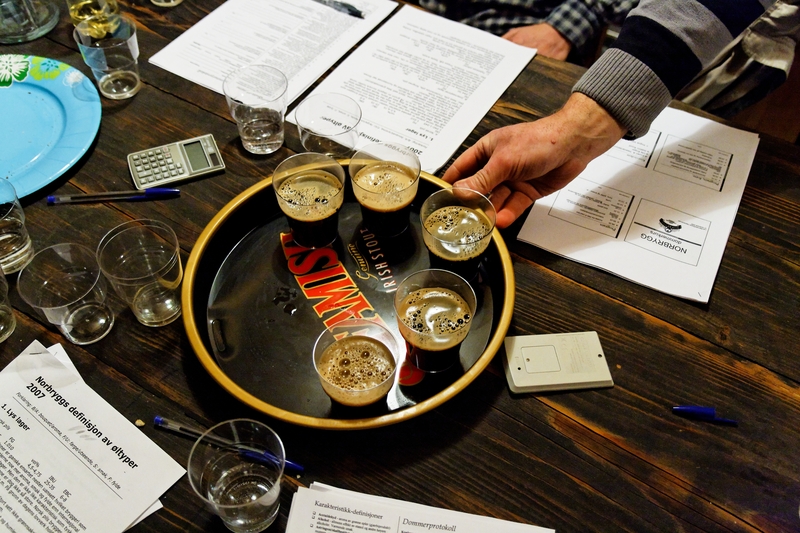Experiments in blind tasting

At the course |
I've written before about my experiences as an uncertified beer judge, and when the Norwegian homebrewer's association offered their beer judge certification course again this year I decided to apply. My goal was to learn more about the beer brewing process, to improve my ability to analyze beer, and to learn about specific flaws in beer and how to detect them. If I'd also have to teach myself the Norwegian beer style guidelines I decided that was a price I'd be willing to pay.
To join the course you had to apply and explain your background as well as why you wanted to take the course. 10 applicants were selected, just under half of the people who applied, and I was one of the lucky ones. The course was just a single day, designed to help us get a picture of what we need to learn. The exam will be in four months, and was described by one of the instructors as "entirely flunkable". Apparently only 1 in 3 participants passed last year, Geir Ove being one of them.
The course day was held a good distance outside of Oslo, on Nesodden, and so we all gathered at the central station in the morning, to share a taxi out to the course location. This was a brewhouse which one of the instructors had set up next to his home. This brewhouse had various steel vats, a small bar with a tap, and a table with just enough room for the participants and instructors.
The course had a theoretical part, mostly covering the role of the beer judge, the brewing process, and various chemicals in beer. There was also a practical part, in which we were given small samples of different beers. The initial batch was four beers used to illustrate various chemicals in beer. Grolsch was used to illustrate dimethyl sulfide, Grans Bare Øl for diacetyl, and a Cantillon Gueuze to illustrate acidity. To illustrate oxidization they took Ringnes Pils (the default Norwegian lager), pumped a small amount of sterile air into it with an aquarium pump, and then cooked the bottle in an oven at 70C for a while. The result certainly was oxidized, and very different from the original. We were not told what beers these were until after we had tasted them, but one participant guessed the Grolsch.
We were then given a batch of three unidentified black beers, and told to write notes on them, then attempt to guess the beer styles. After tasting the three we were asked one by one to read our notes on the first one, all of which went along the lines of "roasty, caramel, maybe a bit neutral". The shock was considerable when we were told that it was, again, Ringnes Pils, this time with some black colouring added to it. Every single one of the 10 participants claimed to taste roastiness in the beer, and not one of the 10 so much as came near the idea that this might be a pilsener. An interesting example of the sense of taste being affected by visual signals.
The second beer was described along similar lines, but as having more flavour, more burntness, maybe some alcohol, and some earthiness. One participant guessed that it was Samuel Smith Taddy Porter, and so it did indeed turn out to be.

Taster glasses |
The third beer was again described as having a pretty lasting brown head, being roasty, kind of neutral, maybe a bit sweet, and, by one person, as slightly estery. There was again considerable shock on being told that this was Erdinger Hefe-Weissbier (the pale variety) with dark colouring. We'd again been fooled by the colour into picking up an entirely imaginary roastiness, although the ester character is certainly correct.
I'm still surprised by this result. There was considerable beer tasting experience among the participants. There were three RateBeer users with approximately 8,000 ratings put together, one guy educated as a wine sommelier, two commercial microbrewers, and the rest were certainly not novices, either. And yet while the participants were able to recognize two beers simply by tasting them, they were also fooled into tasting something that was just not there. There is much research and anecdotal evidence indicating that people's sense of taste and aroma are strongly influenced by their expectations, so this shouldn't have come as a shock. But it did.
Next, we were given what's called a triangular test. We're given three glasses of beer, containing two different ones. The task is to identify the one glass containing a beer different from that in the other two. I easily spotted that glass 2 had a beer that was noticeably thinner and waterier than the sweeter beer in glass 1. Then I got stressed and flustered, and consequently messed up the comparison with glass 3, but in the end decided that glass 2 had to be the one that was different. Most people (possibly all) gave the same answer. The correct answer was: 1 Murphy's Red Ale, 2 Kilkenny, 3 Murphy's Red Ale. So we got this one right.
For the last part, we were divided into two groups, and given four beers to sample. Our task was to make tasting notes, then discuss and agree on what type of beer it was, and finally to judge it using the standard judging sheets. The first one we all immediately spotted as a Belgian Wit, probably Hoegaarden, based on the coriander aroma that was quite prominent. The visuals (hazy pale yellow) made this easier, of course. The other group came to the same conclusion. It really was Hoegaarden.
The second we really struggled with, with the group dividing itself over whether this was a German Dunkel or a Brown Ale. It may sound strange that this should be so hard, but the sample beer did not have that much flavour, and it's not trivial to distinguish the dry maltiness of a dunkel from the fruitier nuttier character of a true brown ale. The group argued back and forth for a long time, with some people changing sides during the argument, while others stuck to their guns. In the end the Dunkels outnumbered the Ales 3 to 2, so we settled for that. One of the Dunkels guessed it to be Aass Bayer. The other group also struggled with this, in the end settling for brown ale. The correct answer: Frydenlund Bayer (a dunkel).

Bar tap |
On the third beer we all agreed it had to be some sort of ale, and after some discussion (bitter? pale ale? brown ale?) we decided to settle for Brown Ale. The Norwegian style guide distinguishes between English and American Brown Ale, but we ignored this. One person guessed it to be a home brew, perhaps even the host's Lobster Duck Fat Brown. My recollection is that the other group also settled for brown ale here. The answer: Dischler Fat Brown. (Lobster Duck is a different beer.)
The fourth beer was black, with lots of flavour, and all five group members agreed it must be some sort of porter or stout. One person immediately claimed to recognize Samuel Smith's Imperial Stout. The discussion went back and forth a bit here, too, over porter, oatmeal stout, imperial stout, etc, before it was agreed to assume imperial stout. Again this may sound odd, but with no reference points it's not really that easy to determine how powerful a given beer actually is when you taste it. Some of the members were also not that clear on the finer points of the different porter/stout types, which of course made things harder. The other group chose imperial stout here. The beer did turn out to be Samuel Smith's Imperial Stout.
At the end nearly everyone went off to an excellent dinner at Oslo Spiseforretning, a fine restaurant in the oldest part of Oslo, accompanied by three excellent beers from Haandbryggeriet. The waitress did the usual spiel of introducing the dishes and beers, and was a bit surprised to find the group giggling on being told that porter is a dark beer. It was a very good dinner, much enjoyed by all. Normally people would have been up for several beers after dinner, but on this occasion everyone was completely wasted after a long and intense day, and so everyone retired home.
Now follows a bit of study to learn the style guide, and probably some study group meetings to practice judging beer. And then, in March, the exam.

The last beer |
Similar posts
European Beer Festival '08
The Danish Association of Beer Enthusiasts have been arranging beer festivals for several years, but this year was the first time I was able to go
Read | 2008-11-13 15:25
How we judge beer in Norway
The state of the Norwegian beer scene never ceases to amaze me, and given that I'm a native Norwegian, I thought international readers might enjoy a look at what goes on here
Read | 2008-08-20 21:04
"Oh, just about every kind, sir"
One thing I've always found shocking as a beer drinker is the level of knowledge about, and, even worse, interest in, beer among the people who make a living serving it
Read | 2005-10-02 21:10
Comments
The Beer Nut - 2008-11-20 10:51:26
Kilkenny really is easily spotted due to its utter tastelessness. I found it very easy to pick out from Beamish Red in a blind tasting.
Jason B Standing - 2008-11-27 14:00:21
That's fascinating - I live in constant paranoia that someone's going to make me do a taste-off between 2 identical beers and I'm not going to get it... I like the idea of giving distinct "baseline" points for taste reference (like when my g/f & I recently bought oaked and unoaked chardonnay because I confessed I didn't know what oak was meant to taste like, despite having it referred to in numerous tasting notes - I know what it is now :).
As an aside, where can you get Beamish Red? I've not seen it anywhere for years!!
Lars Marius - 2008-11-29 09:15:03
I wouldn't worry too much about the taste-off, since this is much harder than it seems. If you get it wrong, that doesn't really mean much.
Here in Norway Beamish Red is available in Ica stores, if I remember correctly. And probably only in those.
Nate Ring - 2008-12-03 14:18:55
I've been looking for advise on how to really engage good beer. It seems to be something of a rarity here in United States. The best beer I have had was in Berlin a pale.
Bailey - 2009-01-05 14:07:34
Thought I'd drop by to let you know that, in the last couple of months, I've refered to this post several times in making the point that lots of what we think is to do with taste is actually bound up in appearance, branding and presentation. Or, to put it another way, not many people have such great tasting skills that they can *really* be objective. Certainly not me! So, thanks, interesting stuff.
The Beer Nut - 2009-02-05 19:24:56
Me again, via the miracle of Boak & Bailey.
Beamish Red has just been discontinued in Ireland by its new owners Heineken. I'm not sure if they'll keep it on in their foreign breweries however, as they already have Murphys Red as their Irish-Red-Which-You-Can't-Buy-In-Ireland.
Oh and we did another blind tasting at ICB. This time English ales.
Jonny Axelsson - 2009-03-02 05:19:09
I recently had to do a variant of a triangle test with white wine. A customer claimed that the bottle (from a small winery) had been mislabeled and it really was the other type they produce. So I made a glass with each of the two types as well as the bottle in dispute. In this case my task was eased by having two out of three glasses of known reference type, but it still wasn't easy. I concluded with 80% confidence that the customer was wrong, but I couldn't be more certain than that.
Evilly I gave him an entirely different glass of white wine than he had ordered at a later occation and he never noticed.